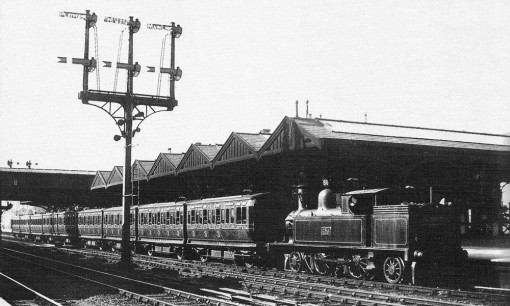Francis Webb’s 4′ 6″ 2-4-2T radial tanks were a natural development of his famous 2-4-0T ‘Chopper’ tanks with an additional trailing radial axle supporting a larger capacity bunker. Indeed in the final order for 2-4-0Ts, a single 2-4-2T was built, and eventually 40 out of the 50 Chopper tanks were ‘renewed’ by being given an extended bunker with a trailing radial axle, and absorbed into the 2-4-2T class.
As with the Chopper Tanks, some batches of the 2-4-2Ts were fitted with condensing gear for work in the suburban districts of both Birmingham and London. Batch numbers E110, E33 and E36 of 1882, 1889 and 1890 respectively were chosen, and thus the locos working in the London area on the Outer Circle from Broad Street to Mansion House were quickly bestowed with their soubriquet.
Locos from batch E110 were fitted with full condensing equipment, but batches E33 and E36 were given a modified form of gear in what can be loosely described as semi-condensing, whereby exhaust steam was diverted from the blast pipe by a valve in the usual manner through a pipe on the side of the smokebox (although in this case pipes either side of the smokebox) into tops of the side tanks above the water level. Any steam remaining, rather than being fed to the opposite tank and then back to the smokebox as usual, passed through pipes inside the cab front weatherboard, along the eaves of the roof, down the outside of the rear weatherboard and into the U shaped water tank in the bunker, where what little remained was exhausted via a tall, thin breather pipe at the rear.
I’ll be using the recently introduced Mercian kit as the basis of the model, but have not yet decided which member of the class to build. I’ve only been able to locate three photos of the condensing tanks in the London area, numbers 781 and 785 of batch E33, and number 663 of batch E36, all of which are very atmospheric, but not particularly useful when attempting to create an accurate model.
Above, No.785 calls at Addison Road c1905. I’ve been told on several occasions that the LNWR took great pride and care over the condition of all its locos, and how white cotton-gloved shed foremen regularly checked their cleanliness, even between the frames – a view I’ve long held as deluded or erroneous at best, the product of rose-tinted hand-me down stories. No small degree of satisfaction on my part then to find No.785 looking not a little work-stained around the gills…
